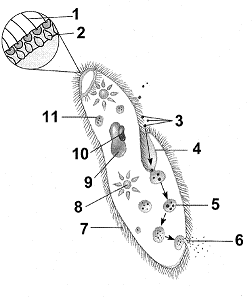Refer to Figure 26-1. The function of the structure labeled 6 is:

a. food intake.
b. digestion.
c. waste elimination.
d. water discharge.
e. asexual reproduction
C
You might also like to view...
Answer the following statements true (T) or false (F)
1. Parasitic relationships are typically loose associations between two species. 2. Character displacement is driven by competition. 3. Resource partitioning occurs between allopatric species. 4. Herbivory by rabbits on a grass species has an overall beneficial effect on the grass.
The brain regulates the amount of cortisol produced by the adrenals by releasing ______, which is a type of _______ hormone
a. testosterone; steroid b. epinephrine; peptide c. epinephrine; amino acid-derived d. CRH; steroid e. CRH; peptide
The California populations of the Northern elephant seal are descendants from a very small population of seals that was overhunted in the 1890s. Heterozygosity in this population would be expected to be ________ due to ________.
A. slight; the founder effect B. great; assortive mating C. great; disruptive selection D. slight; a bottleneck effect E. great; a bottleneck effect
Which of the following statements about the process of forensic DNA profiling is INCORRECT?
a) After a profile has been done, a complete DNA sequence is often used to verify the results. b) Since the tests are often run on very small biological samples, like drops of blood, PCR reactions are used to amplify the DNA before the profiling begins. c) The technique takes advantage of the fact that portions of the human genome vary greatly throughout the population. d) The results are always given in terms of the probability that two individual's DNA could give the exact same genetic profile. e) All of the above choices are correct.